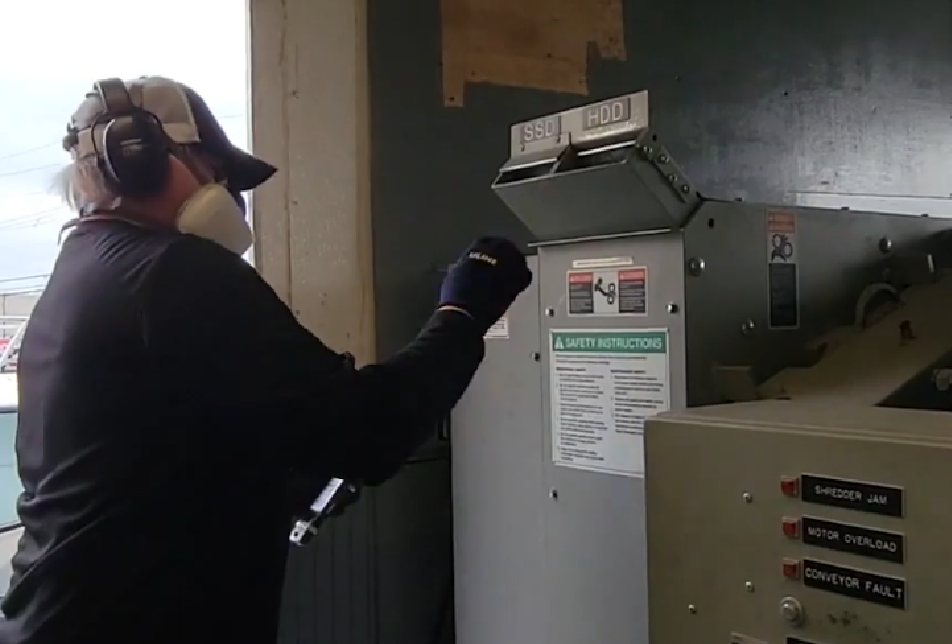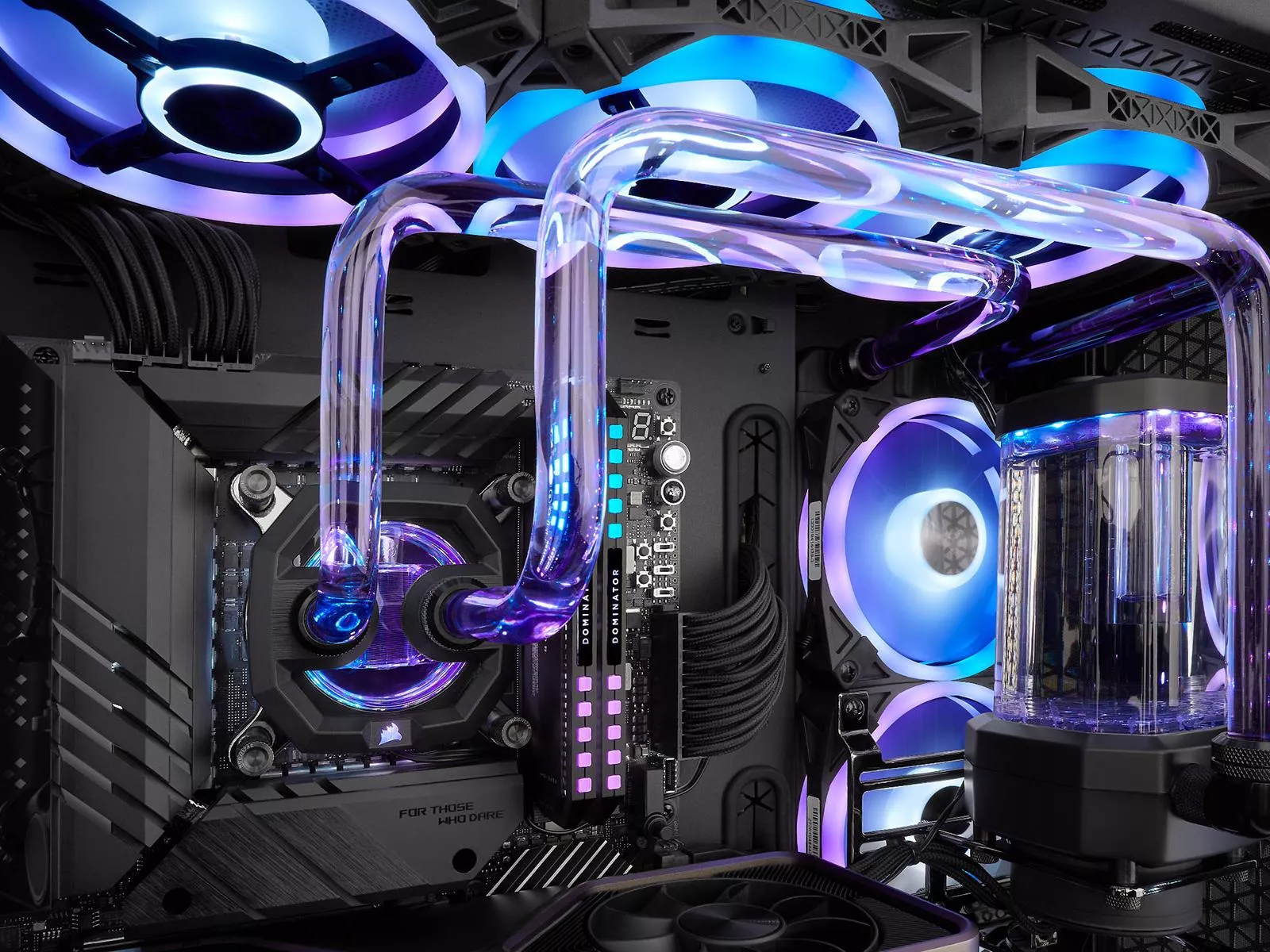A guide to Data Bearing Devices/Assets. Download your free copy here >
Hard Drive Shredding: Answering Your Most Common Questions
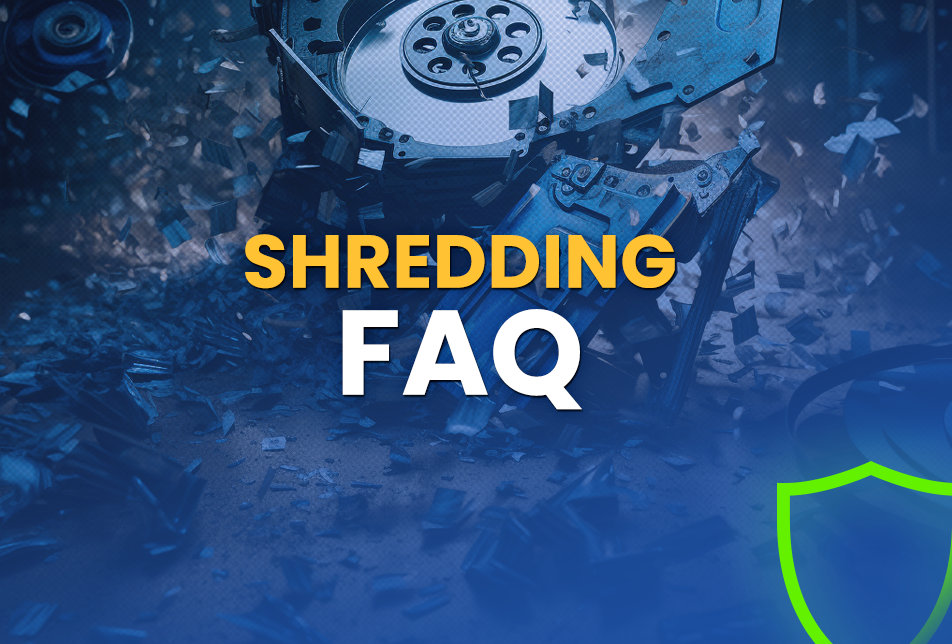
Shredding is a thorough, permanent way to destroy a hard drive, solid state drive (or card) and magnetic tape drives. Using sharp, rotating blades, an industrial shredder slices and tears drives into tiny, irregular pieces so that data can never be retrieved or reconstructed. The smaller the shred size, the less chance of data retrieval.
As the nation’s leading provider of onsite e-data destruction services, we frequently get asked questions from our ITADs, VARs, MSPs and IT Resellers as they’re working with their customers to either quote or prepare for a drive shredding project.
Here are some of the recurring questions we receive. If we’ve missed a pressing or important question, let us know!
- What is the cost of shredding hard drives?
Shredding hard drives, SSDs or other assets is based on several factors including onsite vs offsite, quantity, size (bigger drives take more time), size of shred, etc. Read more details in these articles: Cost to shred hard drives? and Tips to reduce your hard drive shred costs. And, as always, know the value of your data.
Protect your brand from a data breach >
- Is degaussing required before shredding?
Shredding with proper controls such as chain of custody and in-person verifications is most common. For drives that contain federal information, degaussing then shredding of tapes, hard drives and physical destruction of SSDs is unilaterally required. In some instances, we’ve seen corporate stipulations that meet or exceed these requirements. Our recommendation is to always review contracts and verify IT asset data disposition with your client point of contact (POC).
Download Guardian’s free NIST 800-88 guide for more help >
- What type of computer assets can be shredded?
Virtually anything! Just about anything IT! While the world is moving toward miniaturization and chip-based data storage, there are many legacy or museum-quality devices with older, obsolete tech. And many companies have vast storage spaces chock-a-block with equipment that is just waiting for a disposition decision (or the opportunity for theft). Check out devices that store your company data:
- Hard disk drives (HDD) and solid state drives (SSD) of any kind–M.2, SATA, PCMe–pulled from desktops, laptops, servers, cards,
- System boards
- Floppy drives (3.5, 5.25, 10”)
- CDs, DVDs
- Magnetic tape and tape drives (reel-to-reel, backup, cassette, etc.)
- USB thumb drives
- Smart credit cards with memory chips and RF (radio frequency) tags
- Memory cards
- Devices such as cell phones and tablets
- Hidden drives in copiers, printers, all-in-ones and POS (point of sale) devices
- What is the chain of custody process for shredding?
Guardian Data Destruction is fiercely diligent about our dual-signature chain of custody process. Every time a load or project switches hands, location or status (i.e., hard drives for shredding), a document is signed by the consignee and consignor and stored as part of our complete project documentation.
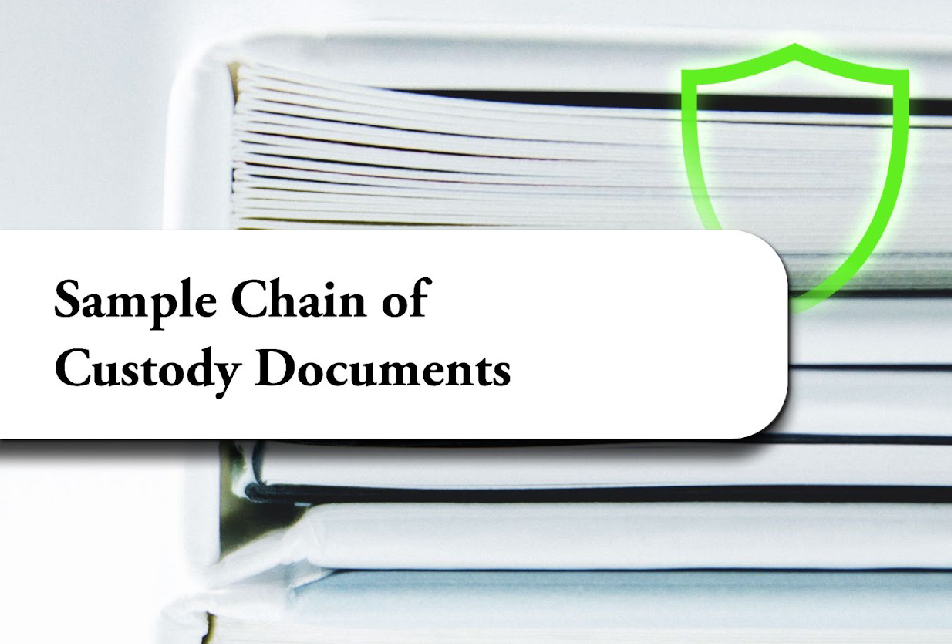
Learn more about the importance of chain of custody >
Why Eric Dorn of Sipi is up at night when data-bearing devices are in transit >
- What is the output or shred size of a shred truck?
Guardian Data Destruction can shred just about any requested size. The largest size is 30mm shred and the smallest shred size is 2mm or dust. See this video for a comparison of the size.
- How do I know what shred size to require or get quoted for?
Under US data sanitization regulations, NIST requires a shred size that is “small enough that there is reasonable assurance in proportion to the data confidentiality, that the data cannot be reconstructed.” Because size does matter (request a “Size Matters” t-shirt), drive shredding is not a one-size-fits-all solution. Considerations:
- Client and project contracts to determine rules for data sanitization including drive erasure for lease returns and degauss-then-shred rules for Federal projects.
- Time and cost. Generating a smaller shred size takes more time than larger pieces, especially for physically bigger, higher-capacity hard drives. As an example, shredding an older (still out there!), 500MB hard drive takes less time than a 22TB hard drive (note, the same time and cost rule of thumb goes for drive wiping smaller vs larger drives as well.)
- Know the regulations for NIST 800-88 Clear, Purge, Destroy
Download Guardian’s free NIST 800-88 guide for more help >
- Media limitations:
- SSDs (solid state drives) require a much smaller shred size because the flash memory itself is so small. If you used a 30mm shred blade for chewing up SD memory cards, you’d likely see the cards just falling through the blades unmarked or barely touched. For all types of SSD drives and cards, including SATA, NVMe, M.2 and PCIe, always insist on 10 mm or smaller such as 2mm shredding, the smallest shred size available.
- Tapes require fine shred or a combination of degauss + shred or shred + incineration
- Cell phones (or any device) with a battery can cause a fire when added to a shredding machine. Batteries must be removed first to be shredded.
Ask about cell phone data destruction that does not require battery removal >
- Industry, company and departmental regulation and requirements that govern data destruction due to data type and sensitivity
View regulations governing data destruction>
View your industry and its considerations >
- What is the smallest shred size?
Guardian Data Destruction offers SSD shredding down to 2mm.
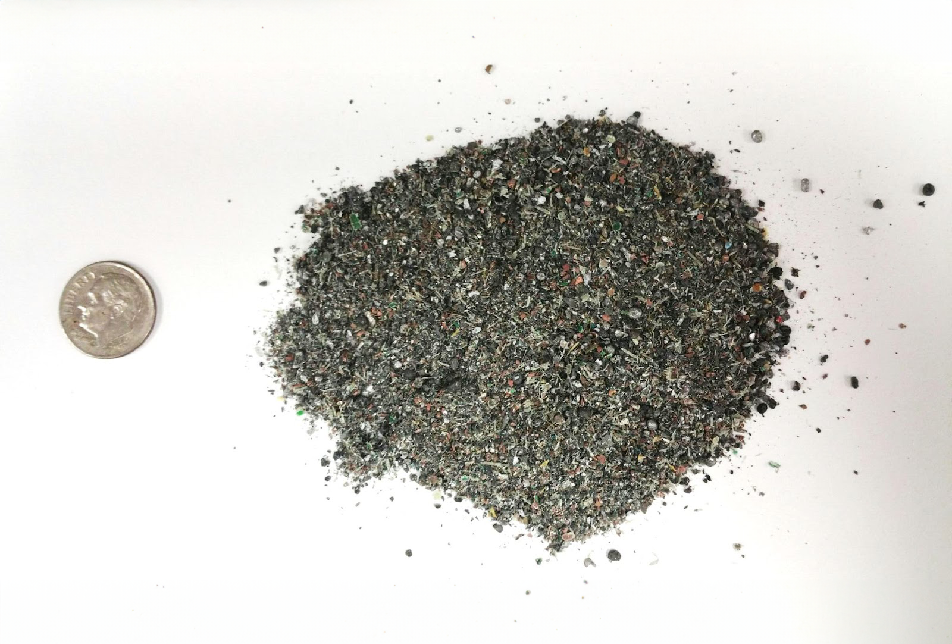
- How long does it take to shred hard drives? How long to shred SSDs? Magnetic tape?
Overall, drive shredding is the fastest and least cost method of data destruction. All of Guardian’s onsite shred trucks have a feeder arm that delivers the drives into the blades, shredding area. In round numbers, Guardian shred trucks can shred up to 500 3.5” or 1000 2.5” laptop drives per hour, 1500 SSDs per hour and 750 tapes per hour.
- How many drives can be shredded in one day?
Depending on the electronic media, multiply by 8 to cover a standard work day per onsite shredder truck. And, don’t forget to factor in:
- extra outside transportation time (are Gaylords of pulled drives able to be brought to and into the truck without downtime?
- additional services (have the project count and serial number verification scans been processed already?)
- # of shred trucks (the beauty of an online shred truck fleet is that multiple trucks can be driven to a single location for large or urgent projects)
- is there a loading dock to ensure quick loading and unloading?
- security and chain of custody requirements (onsite witnessing, weight comparisons, video, counts, etc.)
- onsite workforce – every Guardian project has a skilled, scheduled workforce assigned to meet project requirements. We can provide continuous, round-the-clock data destruction (shred or wiping) as needed.
- Does the customer have to take the drives out of the cradles?
For many customers, replacing the cradle is expensive so separating the cradles from the drives can reduce overall replacement hard drive cost. While Guardian does not require the hard drives to be removed from the caddies for shredding but, as a part of any shred or degaussing project (which does require caddies to be removed) Guardian Data Destruction can provide that separate service.
- Is the shred truck (or the shredder on the shred truck) self-powered? (Does it need access to power?)
Guardian Data Destruction shredders (“shred trucks”) are powered by onboard generators. We do not need access to power from your building or job site.
- Does the shred truck need access to a loading dock?
Loading docks of standard height (48”-52”) are not required but make an operation far more time efficient. Drives and tapes to be shredded are typically wheeled onto a shred truck, ideally, within a locked rolling security container, or by Gaylord or pallet using a pallet jack or forklift. The resulting shred material is fed into a Gaylord as the drives are shredded and also removed by a pallet jack or forklift as it is filled. Without a loading dock, the materials moving on and off the shred truck have to be lowered, wheeled and raised each time.
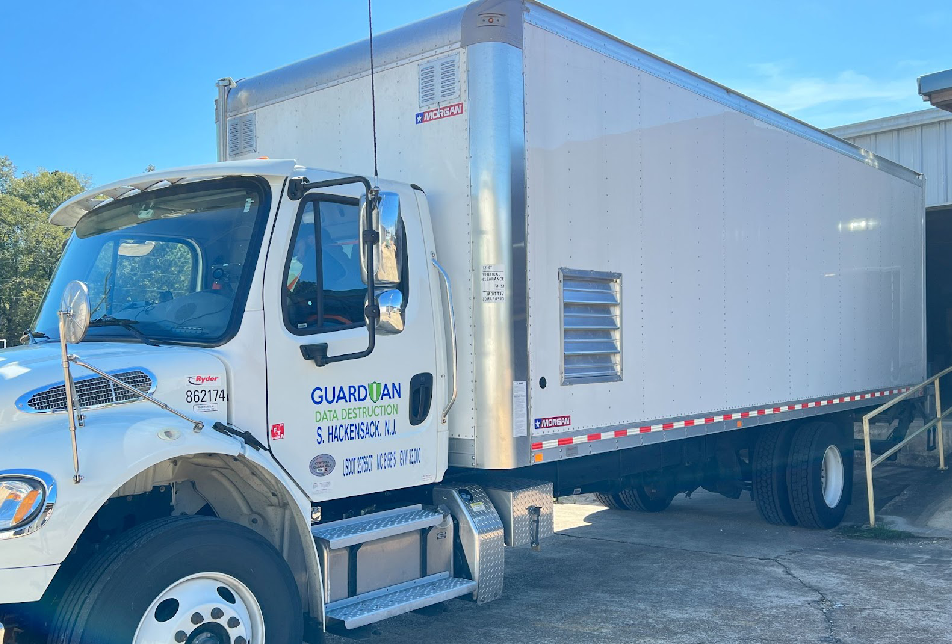
- How many days in advance do I need to schedule a drive shredding job?
Scheduling onsite data destruction is subject to availability and we’ll always work with your client’s schedule to ensure that data is never at risk.
Our recommendation: even if you don’t have all the details, work with the Guardian Shred Team with the information you do have as early as possible. We can get you a ballpark quote, pencil in a date, truck(s), personnel and # of days onsite. (Moving it back is typically much easier than squeezing a project in.) Offsite shredding projects at our New Jersey site can be easily accommodated in non-urgent situations.
- Once I contact Guardian, what is the turnaround time to set up a job?
Our goal for accurate, detailed quoting is 24-hour turnaround. Scheduling can be immediate upon authorization. For rush projects, accurate information will speed up the process.
Ask us for a drive or tape shred quote >
ITADs, VARs, MSPs and resellers, learn why you should partner with Guardian >
- Where are the Guardian shred locations?
Guardian’s mobile truck fleet is distributed across North America in a hub system so that one or more of our shred trucks can be scheduled to any onsite location.
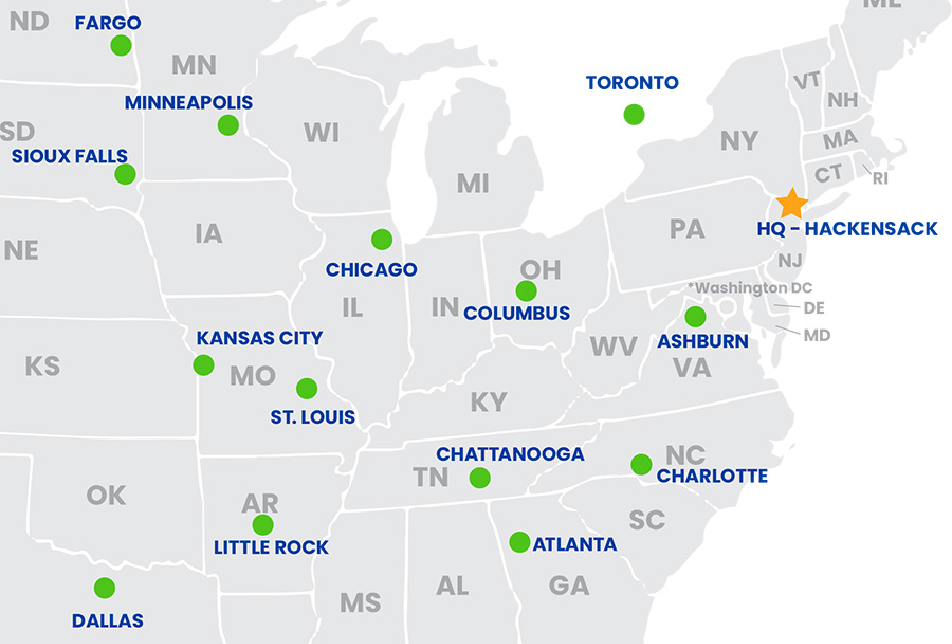
View our shred truck hub map >
- If my project includes shredding, deguassing and erasure (wiping), is it the same Guardian team doing all of it or are there multiple teams?
It depends on the project needs. If there is a lot of shredding and some erasure, it is likely to be the same team. If there is a lot of shredding and a lot of wiping and a lot of degaussing, then it may be two or more teams needed to complete a project.
If your shred project is part of a data center relocation or decommissioning project, we may have one team working on the cable mining, decom and auditing, another group pulling hard drives and then a third team doing continuous shredding.
And if there’s tight project timing, we may need more than one team in rotation so that data destruction is in process around the clock.
For all our projects, you can be assured of skilled labor, proper processes and a clear project management chain of command. If you have a specific team or timing request, let us know.
- Certificate of Data Destruction
- Media Destruction Form
- Serial # Scan Sheet (if scanning was included in the project)
- Recycling verification (R2 or e-Stewards)
- What documentation will we receive?
For shredding projects, Guardian provides a
Guardian’s mobile truck fleet is distributed across North America in a hub system so that one or more of our shred trucks can be scheduled to any onsite location.
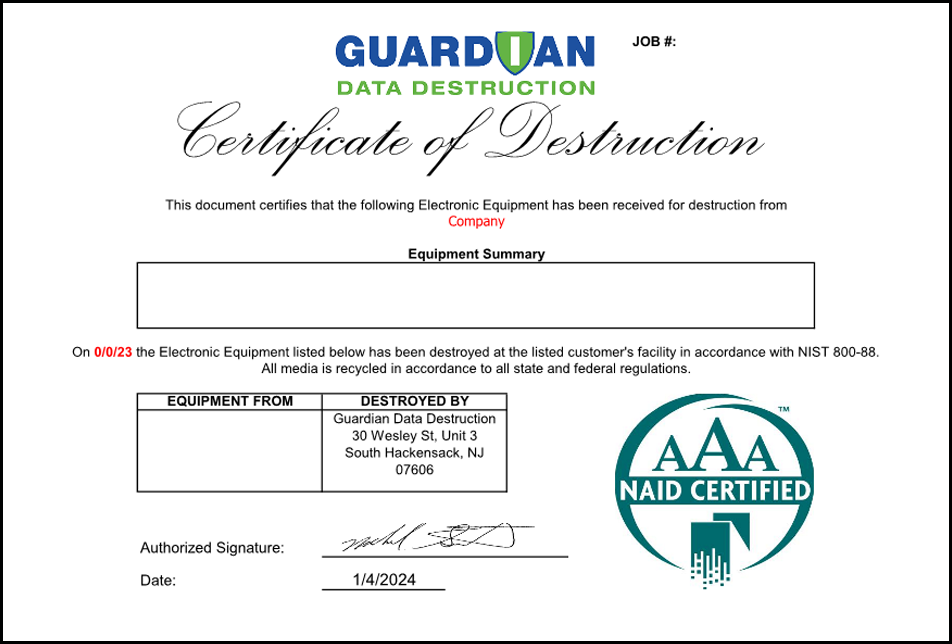
Learn more about a Certificate of Data Destruction >
- How long will it take to receive project documentation?
Guardian Data Destruction generally supplies all documentation to the customer’s VAR, ITAD, MSP or IT Resellers within two business days of project completion.
- Can we witness the shredding of our drives?
Guardian encourages customer witnesses of the process from outside the shred truck. At the end of a project, the customer point of contact is asked to do a walk-through of the truck and worksite to verify that all drives have been destroyed.
- Can you validate hard drive serial numbers?
Of course.
- Can we have our shredding process video documented?
Yes. We’ll work with your stakeholders to determine recording and video file-sharing needs.
Shredding drives is Guardian’s specialty
We’re focused on providing best-in-class drive and tape shredding services to make sure that your customers are protected. Guardian Data Destruction works hand-in-glove with ITADs, VARs, MSPs and IT resellers to ensure that all residual data is shredded, wiped or degaussed on any type of media or device.
If you have questions about our tips or need assistance, don’t hesitate to reach out. And be sure to ask for a quote and demonstration project to compare your current hard drive shredding services with the industry’s best.
